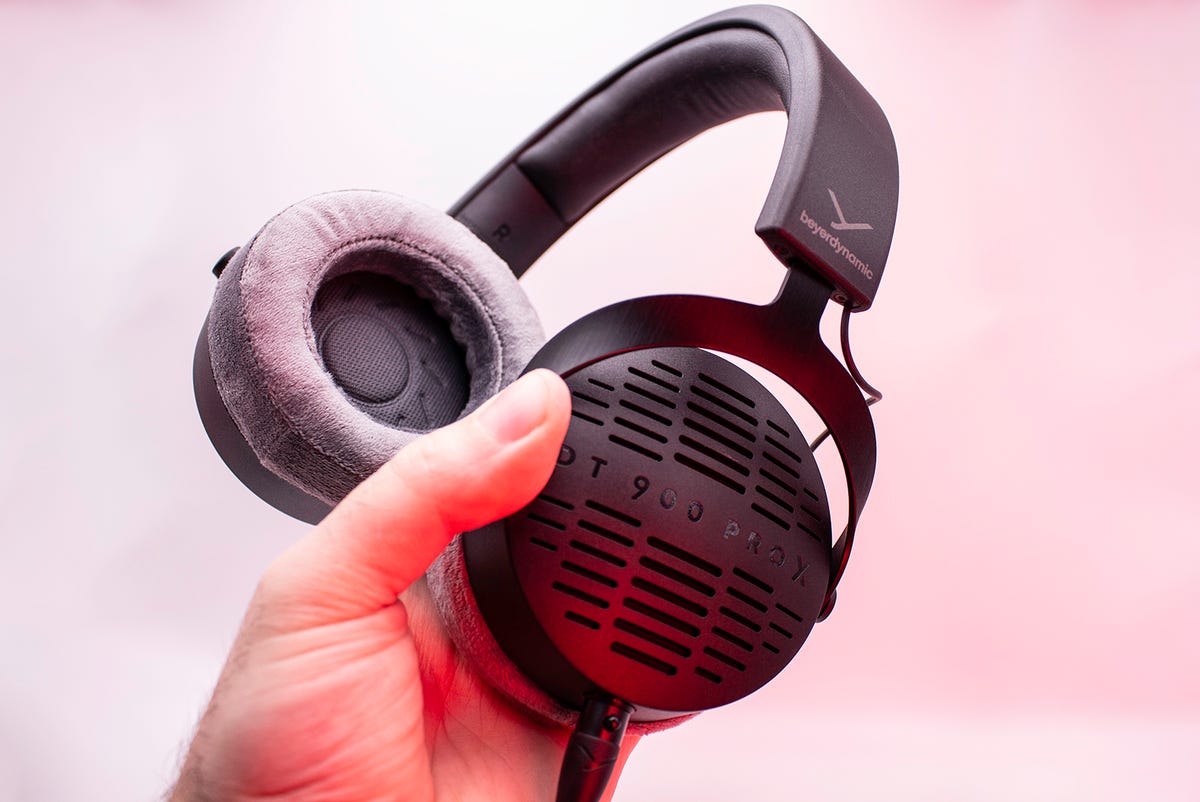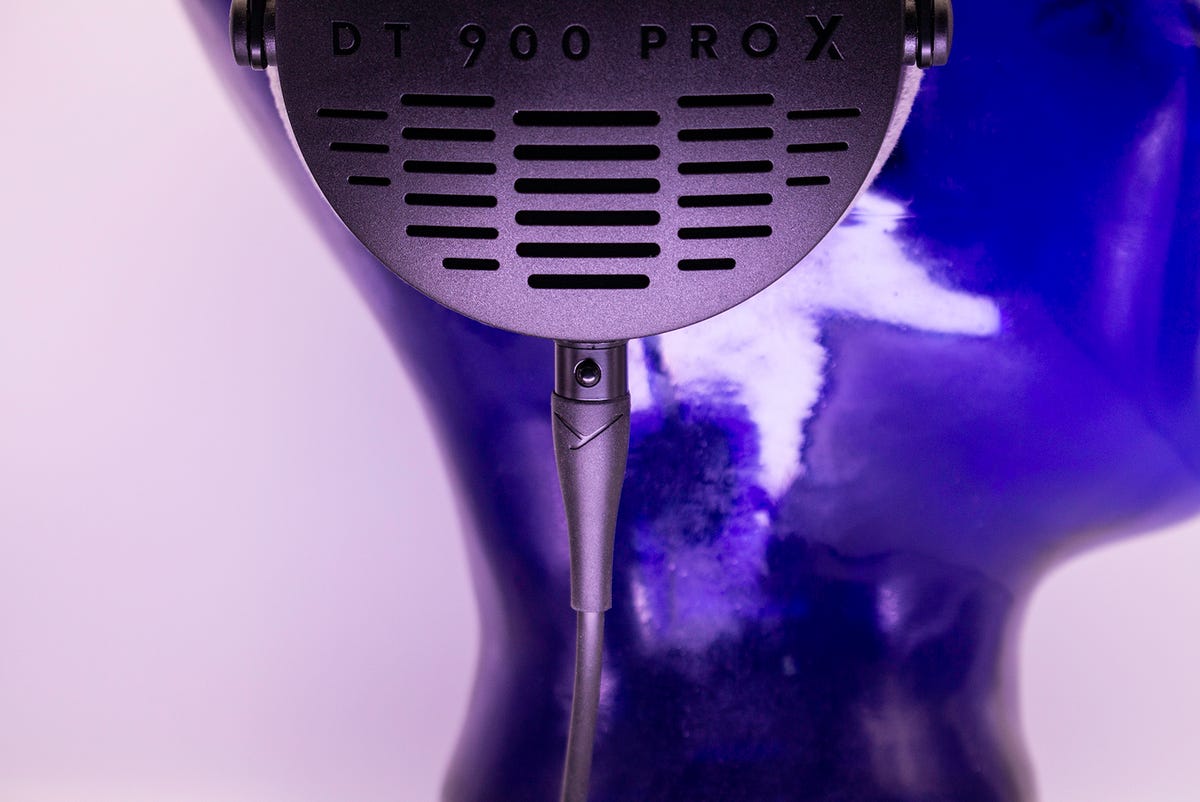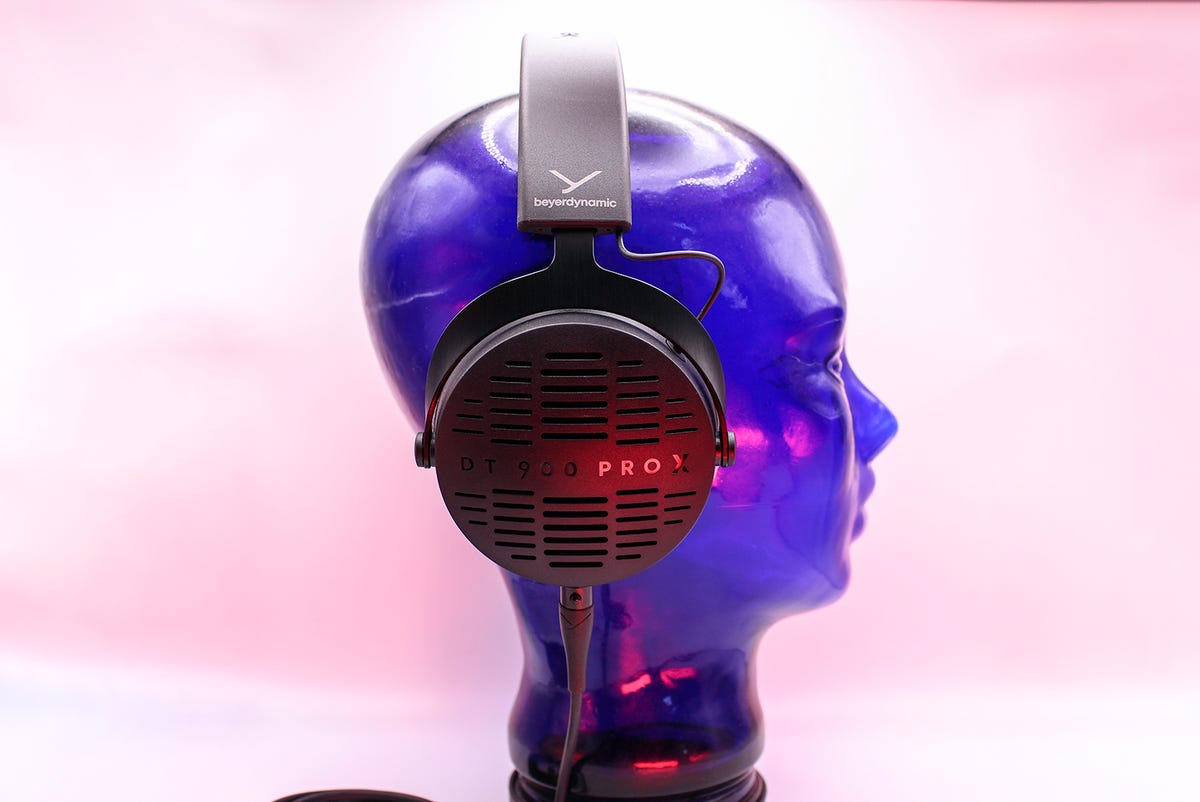Beyerdynamic’s DT 990 PRO headphones were one of the company’s biggest hits in recent history. Marketed as “studio headphones for mixing and mastering,” these $180ish cans provided a cost-effective entry point for budding audio engineers, mixers, DJs, and anyone seeking a transparent, affordable over-ear headphone.
That success was further boosted when they began receiving widespread adoption in the gaming space, largely thanks to popular Twitch streamer Ninja using them as his headphones of choice. The same accuracy and transparency that helped mixers tune musical recordings could also help gamers detect enemy footsteps and locate unseen foes.
Now, Beyerdynamic has gone back to the well for the DT900 PRO X headphones. Similarly marketed as “studio headphones for critical listening, mixing & mastering,” this pair of open-back cans is priced at $299, right between the $180 DT990 PROs and the $600 DT 1990 PROs. The new entry is purpose-built to provide a mid-range solution for audio mixers, gamers, and anyone interested in analyzing every vocal note, drum hit, and string reverb in their music.
Like
- Solid but lightweight construction
- Exceptional instrument separation for analytical listening
- Well above average gaming performance
- Two included cable lengths
Don’t Like
- Very tight, overly intimate soundstage
- Headband has some comfort issues, especially for larger heads
- Mini-XLR connector can annoy your shoulder
Build and features
The external construction of the DT 900 PRO X is a mix of metal and plastic. The large, circumaural earcups are the latter, as is the outer covering of the padded headband. The forks supporting those earcups are metal, with a brushed aluminum finish, and the internal headband is made of pliable spring steel. These materials combine to create a sturdy-feeling product that comes in at 345g without its detachable cables.

3m cable (left) with 1/4″ adapter installed, disconnected 1/4″ adapter (centered), and 1.8m cable (right) with 3.5mm connector showing.
Michael GariffoThose cables connect to the headphones with a single-sided, 3-pin mini-XLR, a sort of shrunken-down version of the full-sized XLR connector you’ve probably seen used in microphones. The connector provides a solid, satisfying click when the included 3m (9.8 ft) or 1.8 m (5.9 ft) cable is inserted. Both cables connect to your source via a gold-plated 3.5mm stereo connector, or via the single included 1/4″ gold-plated adapter which screws onto the 3.5mm jack for extra security.
Internally, the DT 900 PRO X features Beyerdynamic’s STELLAR.45 driver with a frequency response of 5 – 40,000 Hz and a nominal impedance of 48 ohms. Those drivers sit behind the circumaural ear cup padding, which consists of a layer of ergonomic memory foam covered in gray velour.

Comfort
No matter how spectacular any headphones sound, you’re unlikely to wear them if they’re uncomfortable. While the DT 900 PRO X was far from the comfiest pair I’ve ever used, they were by no means the worst.
On the positive end, the included memory foam provided an ergonomic fit, and the velour padding was a pragmatic choice given the nature of this model.
The DT 900 PRO X is open-backed, which means air and sound are allowed to transmit freely through the grills on the backs of the earcups. Without going too deeply into the open-backed versus closed-back debate, open-backed headphones are generally praised for their more natural, speaker-like sound, while closed-back headphones are lauded for the extra bass their seal helps produce and their ability to block outside noise.
More: Best noise-canceling headphones
Closed-back headphones often opt for leather or leather-like materials since they’re better able to seal soundwaves in or out. Unfortunately, that also usually means sealing in heat, which can lead to sweaty ears and long-term discomfort. Meanwhile, velour is more breathable, but allows some sound leakage. Since sealing the DT 900 PRO X’s open-back earcups was never possible, the use of velour makes perfect sense and communicates an overarching theme of thoughtfulness in the headphone’s design.
I will say that the earcups were a bit too small to comfortably enclose my ears without touching the tops and lobes. Those with smaller ears will likely find them roomy enough.
Unfortunately, I can’t be quite as positive about the headband, for two reasons.
First, I had to max out the size adjustments to achieve a relatively suitable fit. Even then, the tightness of the earcups meant the headphones felt just barely large enough. To be fair, my head is on the larger end of the spectrum, but not big enough that I don’t usually have a little leeway in most other manufacturers’ products. This issue led to the headband creating a pressure spot at the crown of my head after long-term use, typically a couple of hours. Of course, if your noggin’s smaller than mine, this likely won’t be an issue, even after multiple hours of use.
The second problem, however, may plague a wider audience, even those with average-sized heads. That problem is what’s called clamping force, a measurement of how hard a given pair of headphones squeeze your skull when worn.
More: Best Bose headphones: For audiophiles to athletes
I’ve tested brand new headphones that feel like they’d fall off in a stiff breeze and others that made me feel like my head was in a vise. While these don’t reach either extreme, their clamping force is overblown for a pair of cans designed to be used seated at a desk or mixing station.

The tightness here is something I’d expect in a pair of workout headphones that need that extra squeeze to stay on while exercising. To be clear, it’s not tight to the point of immediate pain, but it is mildly unpleasant over multiple hours of use.
One final issue with the comfort of the DT 900 PRO X comes from its connector. To be blunt, it’s annoying. This is a problem I’ve noticed across multiple Beyerdynamic sets using the mini-XLR connector, including the more expensive DT 1990 PROs. In every case, the connector frequently pokes me when I move. Any unconscious head tilt to the left pushes the connector and cable into my shoulder, producing discomfort, and bending the cable at an alarmingly tight angle.

The rigid connector’s extended length can be seen here.
Michael GariffoOf course, over time I adjusted to this by simply not bending my neck that way. But, I can’t say I appreciate my range of motion being limited like this. Other manufacturers that use similarly long, rigid connectors angle their connection points forward, toward the front of the headphones, to avoid this exact issue. Beyerdynamic may wish to take a page from their books.
While the comfort of the DT 900 PRO X can’t match the ability of something like Sennheiser’s high-end offerings (which I have very literally forgotten I was wearing at times), it isn’t exactly painful. Still, those at the larger end of its fit range may want to take a break from it every few hours.
More: Best wireless earbuds

Sound
Obviously, this is the single most important metric of the performance of any piece of audio equipment, especially one being marketed to those responsible for producing music themselves.
It’s important that we establish something up front: there really isn’t any such thing as “universally good sound” in the high end of the audio market, particularly when referring to headphones as laser-focused as the DT 900 PRO X. There is, of course, “bad sound,” which I would consider any sound output that doesn’t do the job it was meant to. In this case, the prescribed task for the DT 900 PRO X, as set down by Beyerdynamic’s marketing language, is to serve as an excellent audio playback solution for sound engineers, mixers, and critical listeners.
For most consumers, the goal of listening to music is purely to enjoy it. This means the sound being produced should be, at all times, pleasant. Engineers often go out of their way to tune general-purpose headphones to be able to beautifully reproduce sounds ranging from the deepest kettle drum and the tiniest chime, all without offending or fatiguing the listener’s ears. Such priorities can produce headphones that purposely eliminate the piercing aspects of overly harsh high notes, or the unpleasant rumbling of deep sub-bass, even if it means altering the original sound of the recording to some extent.
The above description (and admitted oversimplification) of a highly-technical aspect of audio engineering helps illustrate the vast difference in priorities between general-purpose headphones and those designed for audio mixers, as DT 900 PRO X was. To be clear, this pair of headphones will never shelter you from overly harsh treble, or overblown bass. It will, instead, present you with a clear, honest representation of the recording it’s playing back, as it is, with no alteration, coloration, or unwanted enhancements of any kind.
The result is a brutally honest listening experience that reveals each and every flaw in a given track. Analyzing individual instruments and vocals is made easy by the excellent source separation. This lets you concentrate on individual musicians and to visualize each guitar strum or drum hit. Similarly, the DT 900 PRO X reveals flaws in vocals and unwanted or hidden inclusions. Loading up Fleetwood Mac’s 2001 remaster of “The Chain,” for example, allows you to clearly hear the infamous expletive muttered at the track’s beginning that many cheaper or more forgiving headphones can completely blot out.
In short, the DT 900 PRO X fulfills its goal of allowing you to pick apart a track, analyzing every performer, instrument, and unwanted inclusion to help in your ultimate goal of producing the best-sounding track possible. While it does this to what I would consider an impressive level for its $300 price point, it can fall short in a few areas.
The first of these comes in the form of something that analytical headphones often lack: a wide soundstage. Wider soundstages make you feel like you’re physically among the instruments or vocals being played back, complete with the ability to close your eyes and point at individual performers (singers, guitarists, drummers, xylophone players, etc.) where they would be if you were listening to them live.
Soundstage quality does depend on the mixing of a track and the intentions of the sound engineers behind it, but the audio playback device is usually the single largest factor in its final quality. I would call the sound produced by the DT 900 PRO X “intimate.” Tracks like Norah Jones’ “Little Room,” which was mixed specifically to make the listener feel like they were in that eponymous space, shine on these headphones. Everything in that track feels like it’s centered between your ears, with all instruments and vocals equally detailed, but also identically located.
More: Best stereo speakers: Build the perfect system
Meanwhile, the components of tracks like Jennifer Warnes’ “Bird on a Wire,” which is widely known for its nuanced soundstage, are crushed together into originating from, at best, left, right, or center.
To be clear, it is possible to offer both analytical accuracy and a better soundstage than what the DT 900 PRO X provides. In fact, Beyerdynamic’s own DT 1990 PROs do a better job of balancing the two. But, those headphones retail for twice as much. Whether or not that doubled price is worth the improved sense of physical space is up to the individual listener and their wallet.
The other drawbacks of the DT 900 PRO X headphones are far more minor. For one, their 48 ohm impedance means that many users will max out their laptops or smartphones while driving them, and might still wish for a bit of extra oomph on quieter tracks. This can be solved by using a basic headphone amplifier, of course, and might even be a good thing for those of us hell-bent on giving ourselves long-term hearing damage with overly loud music and games.
Particularly cacophonous tracks also occasionally hurt this model’s ability to provide accurate instrument separation and analytical clarity. Though this was an infrequent enough occurrence for me that it could just as easily have been the fault of poor mixing on the track than any weakness in the DT 900 PRO X.
Ultimately, the DT 900 PRO X is a headphone that punches precisely in its weight class, both within the Beyerdynamic lineup and the market at large. It definitively beats the cheaper DT 990 PROs for analytics, but can’t quite match the more expensive 1990 PRO for crystalline clarity or soundstage reproduction. It is exactly what the company meant it to be: a solid, revelatory pair of headphones for the middle market, aimed squarely at sound engineers and mixers.
Gaming
I chose to add this brief section due to the aforementioned popularity of the DT 990 PROs among the gaming community.
I tested the DT 900 PRO X headphones across multiple genres on PC, including first-person shooters (FPS), cinematic adventure games, and RPGs.
For FPS games, the headphones produced dead-on accuracy for audio source direction on the horizontal plane, allowing me to easily pinpoint the direction of my enemy or a given sound effect. It didn’t do quite as well on the vertical axis, but this is a far rarer skill that tends to be limited to either extremely expensive headphones, like Sennheiser’s HD 800 series, or purpose-tuned gaming headsets, like the surprisingly adept Razer Blackshark V2 Pro wireless headset.
More: Razer Blackshark V2 Pro headset review: A potent weapon for the right gamer
In other genres, the DT 900 PRO X did an admirable job of replicating sweeping scores, communicating the cramped, ominous sounds of dungeons in titles like Elden Ring, and producing clear, recognizable audio cues across all of them, even during loud, chaotic battle scenes.
All in all, I would recommend the DT 900 PRO X for gaming only if you’re also intending to use them for their primary, intended purpose. The $300 price point is more than twice what far better gaming-centric options, like the aforementioned Razer solution, can be purchased for. That said, I would have no qualms about keeping these on after a long day of mixing to get in some competitive rounds in Halo Infinite or Valorant.
Wrap up
From start to finish, the DT 900 PRO X is a product that does precisely what it says on the tin: provides you with a relatively affordable, brutally honest audio solution for mixing and audio engineering. It’s few – completely understandable at this price point – weaknesses can be largely avoided through the occasional listening break, a little judicious equalization, or conscientious source selection.
The DT 900 PRO X will never be the most universally pleasant sounding thing you’ve listened to. But, that’s exactly how they were designed. If something sounds unpleasant when played back through them, you can rest assured that it will also sound unpleasant across any honest audio output solution. Likewise, if you manage to mix, tune, and edit a track to the point where it shines on the DT 900 PRO X, it should shine just as brightly, if not more so, when played through anything out there, including far cheaper headphones from less careful manufacturers.
The only buyer that I expect may be displeased with their purchase of a pair of DT 900 PRO X headphones is one that went into that acquisition uninformed about what the intended purpose of them is. Hopefully, having gotten this far in our review, you know now not to make this mistake. Now you can decide if these extremely accurate $300 headphones are right for your audio mixing setup and budget.
Alternatives to consider
- Sennheiser HD 600 – An entry from Sennheiser that’s tuned to provide a similarly intimate soundstage and extremely accurate sound reproduction for around the same price.
- Audio-Technica ATH-M50X Professional Studio Monitor Headphones – The go-to budget headphones for many countless mixers over the past several years. They feature a slightly less purpose-tuned sound, but also cost half as much.
- Beyerdynamic DT 1990 PRO – An upgraded option for those ready to invest about twice as much. They provide better soundstage, an even better build quality, and some of the best gaming performance out there.
- Sony MDR7506 Professional Large Diaphragm Headphone – Sony’s sub-$100 option that’s good enough to be practically a ubiquitous presence in every mixing booth and recording studio regardless of their budget. Chances are you’ve seen their trademark blue and red earcups more than a few times.
- Drop + Sennheiser PC38X Gaming Headset – An alternative for those more focused on gaming. Provides some of the best game-focused sound out there and offers a well above-average built-in mic for less than $150.
























